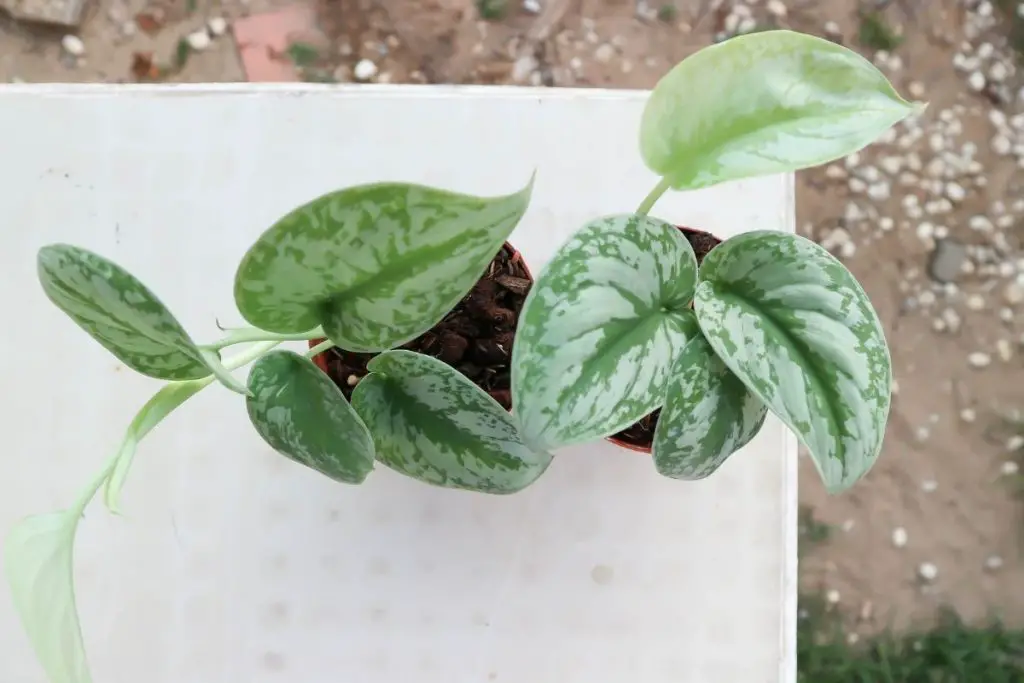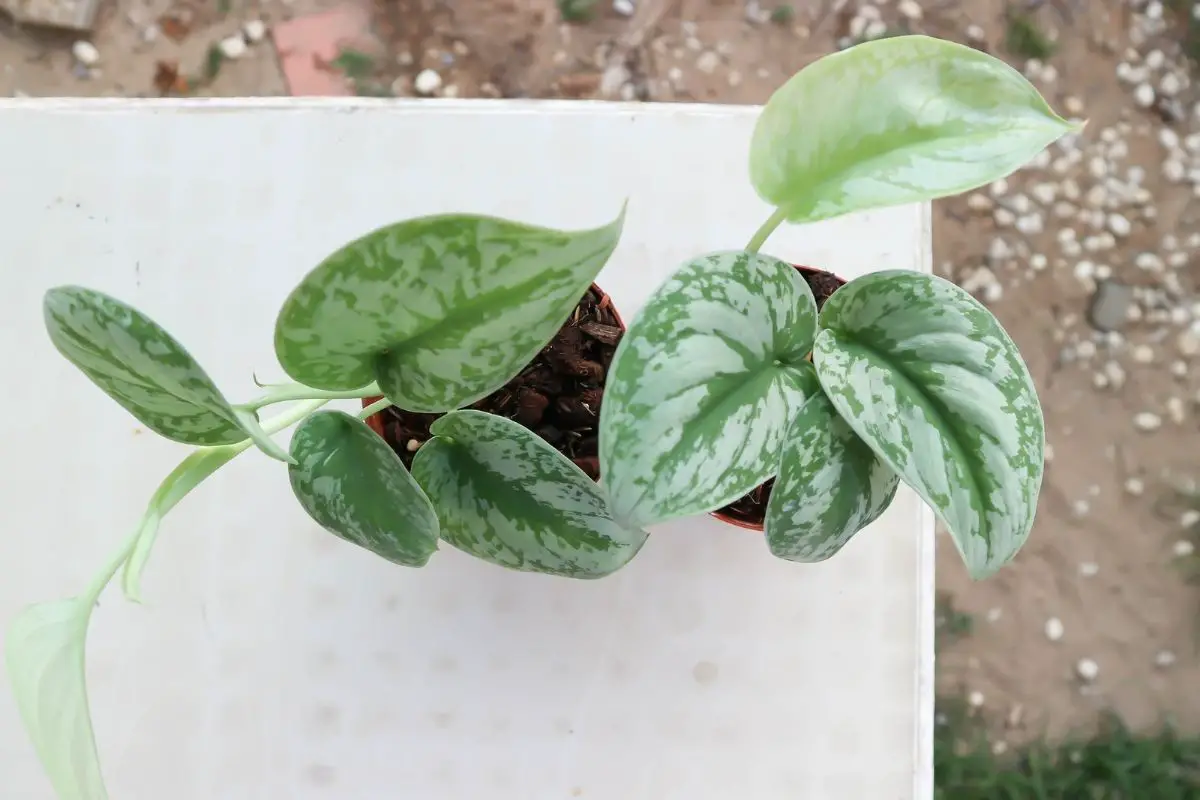Scindapsus pictus ‘Argyraeus,’ commonly named satin or silver pothos (often confused with silver philodendron), is part of the Scindapsus genus and Arum family. Although they are technically not part of the Epipremnum aureum grouping of pothos, they share quite a few similarities in appearance and plant care needs. As a stunning and sophisticated looking cousin to the golden pothos, they definitely deserve a place in this large family of vines!
If you’re lucky enough to have a satin pothos or are thinking about picking one up the next time you visit your local nursery, continue reading! Below is a comprehensive guide to growing and caring for your satin pothos.
How to Plant and Grow
Native to the rainforests of southeast Asia, Scindapsus pictus ‘Argyraeus’ is fantastic to grow indoors because of its love for warm, cozy environments. This is why they are usually grown for decorative purposes.
In their natural habitat, they can grow upwards of 10 feet. When they live indoors, they tend to stop growing around 3 to 4 feet.
These plants love to live in terracotta pots! They can even trail against walls or be grown on a garden trellis.
How to Propagate
The process of propagating satin pothos is almost the exact same as propagating pothos in the Epipremnum genus!
Plant parents often choose to propagate at the beginning of spring. This will allow your vine to grow new foliage much faster than if you were to propagate during the winter.
Step One
The first step of propagation is gathering together your mature plant, a pair of sterilized scissors or shears, and a glass container filled with water.
You can also choose to propagate satin pothos in soil. If you choose this method, you’ll need to additionally grab potting mix and a small container.
Step Two
Next, find a healthy vine to get your cuttings from. Once you’ve located one with about three to six leaves on it, cut back close to the base of your plant. You can propagate the entire vine or cut each leaf off individually making sure to include the leaf nodes.
Step Three
Now that you have your cuttings, you can place them directly into a small glass with water. Any glass container should work just fine!
If you’d rather propagate your plant in soil, simply put your cuttings into a small pot with fresh potting mix. Make a small dent at the top of the soil with your thumb and gently place the leaf node on top of it.
Step Four
If rooting in a glass container, change the water every three to five days and let the roots grow between 1 to 2 inches. This process can take up to a month.
If rooting in soil, make sure the vine is living in moist conditions so that it doesn’t dry out. You can even place a plastic bag over the top of the plant to make sure it is being propagated in a humid environment. In this ideal humidity, the roots will quickly start to grow into the soil.
Step Five
After you see that the roots have grown, you can now say that you have successfully propagated your pothos! Either pot into soil, or if it is already rooted in soil, wait until it becomes rootbound and then repot.

Repotting
When your plant becomes too constricted in its container, repot into a container 1 to 2 inches larger than its current one. Thankfully, it takes 1 to 2 years for these vines to become rootbound so you won’t have to repot often.
Grab some paper towels or newspapers and place them at the bottom of your workstation. If you’re worried about making a big mess, you can also do this job outside.
Fill up your new pot with fresh soil about three-quarters of the way up (check below for the perfect potting mix). Carefully remove your ivy from its container and place it into the new one. Top it off with more soil and tightly but gently pack it with your hands. This will remove any unwanted air bubbles.
Clean up and you’re done!
Care and Maintenance
Care and maintenance for Scindapsus pictus ‘Argyraeus’ are slightly different from the care and maintenance required for the Epipremnum aureum varieties. Even though it is just as easy, you’ll want to follow this devil’s ivy care guide to promote proper, healthy growth.
Soil
These silver satin pothos vines prefer rich, nutrient dense soil with good water drainage. Mix one part potting soil with one part perlite and one part peat moss. This mixture will help ensure your soil doesn’t become waterlogged.
Water
Only water your satin pothos when the soil has partially dried out. The first two inches should be dry before you water again. Overwatering is a common issue with satin pothos that can hopefully be avoided by checking your soil before each watering.
If your plant’s roots are suffering from root rot, its foliage may turn yellow and start to wilt. Repot right away with fresh soil and remove any damaged leaves/roots.
Fertilizer
Feed your Scindapsus pictus ‘Argyraeus’ only once a month during the growing season. Use a half diluted 20-10-10 fertilizer to see the best results.
Pruning
These plants only need to be pruned if you want to manage their size. If not, you can let them continue growing naturally. You may also want to prune if there are any damaged or broken stems.
Get a pair of clean scissors and carefully cut back the stems you’d like to get rid of. Cut close to the base of the plant to encourage new growth! Pruning during the growing season is a great idea so that your plant bounces back faster and better than ever.
Sunlight
Place your pothos in a room that receives about 8 to 10 hours of sunlight a day. Be careful not to put your plant in direct sunlight as this will lead to burnt and cracked leaves. Bright, indirect sunlight is ideal!
Humidity and Temperature
Keep your ivy in a room between 65 to 85 degrees Fahrenheit. Because they are accustomed to living in the tropics, they do better in environments that are above 70 degrees.
They should also be kept in a room with 50% humidity. If you live in a dryer area, this humidity level can be achieved with air humidifiers!
Pests and Diseases
Common pests that can affect silver pothos are spider mites and scales. If you start to see webbing or dots on your plant, this could definitely be a sign of an infestation. Take care of the problem right away by rinsing off the foliage with room temperature water. You can also wipe down each leaf with rubbing alcohol or pesticides if the infestation continues.
Another common issue for these plants is fungus gnats. Root rot can cause fungus gnats to start growing in your plant’s soil. Once they start attacking the roots, you may have a large problem on your hands. There are two potential solutions to this issue! You can let the soil dry out which will inevitably kill off the larvae because they need moisture to survive. Or, you can repot your plant into a fresh potting mix and a sterilized container. With the second option, you’ll want to assess the roots for damage and get rid of any larvae still attached.
Toxicity
Scindapsus pictus ‘Argyraeus’ does contain the same calcium oxalates as Epipremnum aureum making them toxic to animals and humans. These oxalates can even cause slight irritation to the skin when touched. Keep your pothos far away to avoid pothos poisoning in your pets or small children. Do not ingest!
Signs of pothos poisoning include reddening of the skin, swelling in the mouth, vomiting, and asphyxiation. If you are concerned that your pet has consumed large amounts of satin pothos, call your local vet and get them looked at immediately. If you have concerns that your child has ingested pothos, call poison control to get help from a professional.
Growing your plant in a hanging basket may be best if you are worried about this becoming a problem!
Uses of Satin Pothos
Silver pothos can be recognized by their heart-shaped, dark green, and silver flaked leaves. They are mostly used because of these gorgeous decorative qualities! Thus, Scindapsus pictus ‘Argyraeus’ is most used as an ornamental plant.
Although their primary purpose is of course to admire its beauty and add life to the places they live, they are also loved because of their air-purifying abilities. By removing harmful toxins from their immediate environment, they can help reduce asthma, headaches, and allergies.
Conclusion
Satin pothos is a great plant to have in your collection. You can place them in hanging baskets, on your desk, or in any room that needs some extra love!
Follow these helpful tips to see your pothos thrive. With the right care, your plant can live for 10 years!
Check more types of pothos you can grow!
~ image source: depositphotos/jobrestful

